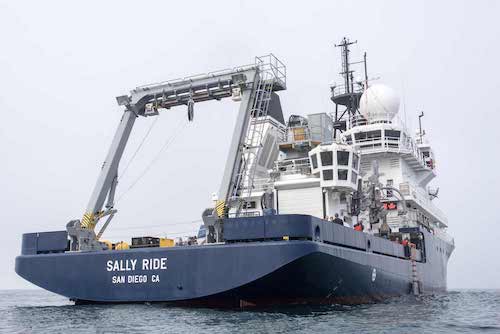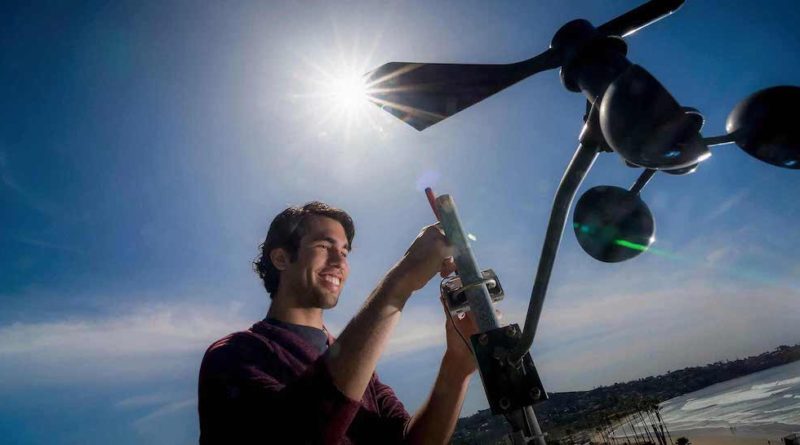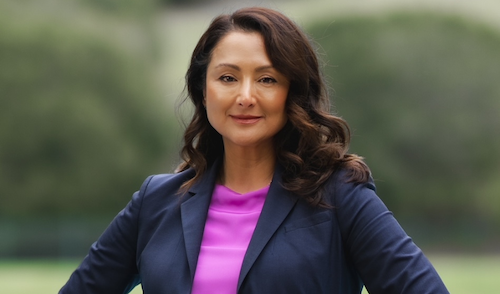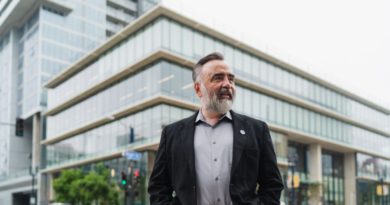Daily Business Report: Friday, Aug. 5, 2022
UC San Diego research funding reaches
record-breaking $1.64 billion
By Debra Bass
From deep sea to deep space, research awards this year provide a window into the tremendous scope of discovery conducted by UC San Diego researchers. In fiscal year 2022 (July 1-June 30), the university earned $1.64 billion in research funding, up from $1.54 billion the previous year—a more than 6 percent increase.
This marks the 13th consecutive year that the university has topped more than $1 billion in research funding.

Among the top 10 investments in university research were $25.6 million from the National Science Foundation to pioneer a method that better integrates renewable energy into power grids and $11.2 million in funds from the Department of Defense’s Office of Naval Research to support advanced computing, instrumentation, and laboratory facilities aboard the oceanographic research vessels operated by Scripps Institution of Oceanography. Both represent multiyear grants that have received steady funding.
Additionally, significant awards in social science areas reflect the diversity of UC San Diego-led research pursuits, including a psychology department award aimed at uncovering the cognitive and cultural foundations of gratitude and a School of Medicine effort to measure the impact of gender equity and empowerment within the field.
Top photo: A graduate student checks a weather monitoring station at the Scripps Institution of Oceanography that provides data for a number of university research projects. (Credit: UC San Diego)
SD Community College District receives
grant to expand use of free online textbooks
A $975,000 federal grant has been awarded to the San Diego Community College District to expand a program that provides free online textbooks and resources to students, saving them the cost of buying expensive books for their classes. The Community Funding Project grant came through the support of Rep. Scott Peters, who sought the funds.
The grant money will be used to develop more zero-textbook-cost courses, which use digital materials that are free to students. Textbook prices, which have risen more than 800 percent since 1978, can be a prohibitive cost for many students, who on average spend about $1,200 a year for textbooks.
Mathematics currently has the most zero-textbook-cost courses, although numerous other areas, including psychology, business, history and English, offer such classes. In fall 2021, students in zero-textbook-cost classes had a 2 percent higher success rate than other classes.
DOJ Antitrust Division veteran joins boutique Bona Law
A U.S. Department of Justice Antitrust Division and BigLaw veteran recently joined antitrust boutique Bona Law in La Jolla. Dylan Carson, who most recently was a partner at Faegre Drinker, joins several fellow lawyers with Antitrust Division and BigLaw credentials.
Carson brings over 20 years of experience working in BigLaw and as a government enforcer.
He served for five years as a trial attorney in the Media, Entertainment, and Communications Section of the Antitrust Division’s Washington, D.C. headquarters.
Before DOJ, he was a partner at Tucker Ellis and worked at Howrey and Kaye Scholer following a federal clerkship.
Bona Law CEO Jarod Bona welcomed Carson as a lawyer who “strengthens our stand-out team with more agency experience and trial leadership skills at a time when companies face greater antitrust scrutiny from the DOJ, FTC, and state attorneys general.”
Carson will work from the firm’s New York and San Diego offices.
USD alumna becomes first Latina elected sheriff in California
When she was 16, Christina Corpus saved enough money from her summer jobs to buy a car, but not just any car. She bought a Toyota pickup truck, a vehicle that supported her active lifestyle and had enough room to drive her friends around the Bay Area.
One Sunday, she headed to Tanforan Mall to pick up one of her friends from work. While she sat and waited, a man tapped her window and pointed a gun barrel at her. Within the blink of an eye, a struggle ensued and Christina fought off her attacker.
The violent carjacking attempt was enough to leave any teenager shaken, but Christina says it was the police officers who arrived on scene that made all the difference.
“It was the way the law enforcement officers responded to me, a 16-year-old, frightened girl, and helped me navigate through that traumatic situation with empathy, compassion and respect, not only at the scene, but also at the trial. That changed my whole trajectory.”
Corpus currently serves as the chief of police services for the City of Millbrae. This June, she was elected to be the next San Mateo County Sheriff, making her the first female elected Sheriff in San Mateo County and the first Latina elected Sheriff in California. She will be sworn into the position on January 2, 2023.
Viasat initiates mechanical integration on ViaSat-3
Viasat Inc. of Carlsbad, a global leader in satellite communications, announced the first ViaSat-3 satellite is now in the mechanical environments build process. The process milestone involves the attachment of the solar arrays, reflectors and other items that will result in the satellite being in its full, launch configuration for the first time.
“Entering the mechanical environments build process is a very significant milestone toward completing the satellite and readying it for flight later this year,” said Dave Ryan, president, Space & Commercial Networks at Viasat. “These efforts demonstrate our momentum to ready the satellite for launch.”
The ViaSat-3 class of Ka-band satellites is expected to provide the best bandwidth economics in the industry with incredible flexibility to move and concentrate that capacity virtually anywhere there is demand — whether it is over land, the ocean or in the air. The first two satellites are planned to focus on the Americas and on EMEA, respectively. The third ViaSat-3 payload is undergoing final integration and testing and will focus on the Asia Pacific region, completing Viasat’s global service coverage.
Rethinking the rabies vaccine
Rabies virus kills a shocking 59,000 people each year, many of them children. Some victims, especially kids, don’t realize they’ve been exposed until it is too late. For others, the intense rabies treatment regimen is out of the question: treatment is not widely available and the average $3,800 expense poses unthinkable economic burden for most people around the world. Rabies vaccines, rather than treatments, are much more affordable and easier to administer. But those vaccines also come with a massive downside:
“Rabies vaccines don’t provide lifelong protection. You have to get your pets boosted every year to three years,” says LJI Professor Erica Ollmann Saphire. “Right now, rabies vaccines for humans and domestic animals are made from killed virus. But this inactivation process can cause the molecules to become misshapen—so these vaccines aren’t showing the right form to the immune system. If we made a better shaped, better structured vaccine, would immunity last longer?”
Saphire and her team, in collaboration with a team led by Institut Pasteur Professor Hervé Bourhy, may have discovered the path to better vaccine design. In a new study, published in Science Advances, the researchers share one of the first high-resolution looks at the rabies virus glycoprotein in its vulnerable “trimeric” form.
San Diego City Council approves updates to Climate Action Plan
San Diego City Council voted 8-0 Aug. 2 to support an update of the City’s Climate Action Plan. Councilmember Chris Cate was absent from the vote.
The update formalizes the city’s goal of achieving 100 percent renewable energy by 2030 and net zero emissions by 2035. It also reinforces the city’s standing as a statewide and national climate leader.
One hundred percent renewable energy means getting all energy from renewable resources – sunlight, wind, rain, tides, waves, and geothermal heat – to be used for electricity, heating, cooling and transport. Net zero applies to bringing global greenhouse gas emissions from human activity into balance with emissions reductions. At net zero, carbon dioxide emissions are still generated, but an equal amount of carbon dioxide is removed from the atmosphere as it is released into it, resulting in a zero increase in net emissions.
Rady Children’s achieves its best-ever rankings
in survey of nation’s top children’s hospitals
U.S. News & World Report announced the results of its comprehensive survey to identify the top children’s hospitals in the country in the new 2022-2023 Best Children’s Hospitals rankings. For the first time, Rady Children’s Hospital-San Diego had four specialties rank in the top 10, the most in its history, topping last year’s survey when three specialties made the top 10 list. Rady Children’s Orthopedics program ranked No. 2 in country; its Neurology & Neurosurgery program No. 8; its Neonatology program No. 9; and its Diabetes & Endocrine Disorders program No. 10. Seven of Rady Children’s ranked specialties were among the top 20 in the nation.
This is the sixth year in a row that Rady Children’s was ranked among the nation’s best children’s hospitals in all 10 pediatric specialties surveyed.
Karina’s Group expands to Barrio Logan
with Karina’s Ceviche Bar ‘N Tacos
Karina’s Group adds to its collection of San Diego dining establishments with a new restaurant and seafood market concept in Barrio Logan. A more casual spin-off of its popular Mexican restaurants, Karina’s Ceviche Bar ‘N Tacos offers a selection of beloved Karina’s dishes alongside a full-service seafood counter and market offering fresh fish, live lobster, and an array of pantry items. Featuring both indoor and outdoor dining, patrons can enjoy Karina’s specialties, such as bacon-wrapped shrimp tacos, surf-and-turf burritos, ahi poke tostadas, and various ceviche plates to-go or on-site. Guests can also purchase fresh seafood and grocery staples to prepare a meal at home.
The new location at 1852 National Ave. in San Diego’s Barrio Logan neighborhood features a 3,000-square-foot market and indoor dining space with a 2,500-square-foot patio space for dining. Guests can order their favorite Karina’s dishes, ice-cold beers, michelucas, and frescas at the restaurant’s counter or peruse the 20-foot-long seafood case for their choice of fresh catch to take home.
Brixton Capital acquires apartments in Seabrook, Texas
Solana Beach-based Brixton Capital has purchased the Regatta Bay, a 240-unit apartment community located at 2555 Repsdorph Road in Seabrook, Texas, immediately south of Houston, for an undisclosed price. The 2003-built property consists of 15 two- and three-story buildings. Amenities include a pool, dog park, tenant lounge and fitness center.
Brixton Capital purchased this property from Miami-based Lloyd Jones and Polaris Realty, who were represented by Matt Saunders of Newmark. Brixton represented itself in the transaction. United Apartment Group (UAG), a San Antonio-based property management firm acquired by Brixton in 2020, will manage the property.
Stos Partners acquires industrial property in Tennesee
San Diego-based Stos Partners, one of the most active commercial real estate investment and management firms in Southern California, announces that it has acquired a 276,081 square-foot industrial building in the Nashville submarket of Spring Hill, Tenn., for $52 million. The property marks the company’s entrance into the Southeast U.S. region, according to CJ Stos, principal of Stos Partners.
Originally constructed in 2019 and recently expanded in 2021, Stos Partners’ recently acquired Spring Hill asset is occupied by a long-term tenant, a manufacturer of automobile door panels. The state-of-the-art manufacturing building features a spacious parking lot, multiple sit entrances, excess yard/truck parking, 14 dock-high and drive-in doors, and 45’ high ceilings for storage and distribution.







